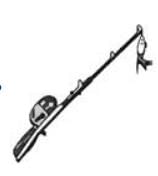Class 5 Exam > Class 5 Tests > Test: Work, Force, Energy And Simple Machines - 2 - Class 5 MCQ
Test: Work, Force, Energy And Simple Machines - 2 - Class 5 MCQ
Test Description
15 Questions MCQ Test - Test: Work, Force, Energy And Simple Machines - 2
Test: Work, Force, Energy And Simple Machines - 2 for Class 5 2025 is part of Class 5 preparation. The Test: Work, Force, Energy And Simple Machines - 2 questions and answers have been prepared
according to the Class 5 exam syllabus.The Test: Work, Force, Energy And Simple Machines - 2 MCQs are made for Class 5 2025 Exam.
Find important definitions, questions, notes, meanings, examples, exercises, MCQs and online tests for Test: Work, Force, Energy And Simple Machines - 2 below.
Solutions of Test: Work, Force, Energy And Simple Machines - 2 questions in English are available as part of our course for Class 5 & Test: Work, Force, Energy And Simple Machines - 2 solutions in
Hindi for Class 5 course.
Download more important topics, notes, lectures and mock test series for Class 5 Exam by signing up for free. Attempt Test: Work, Force, Energy And Simple Machines - 2 | 15 questions in 20 minutes | Mock test for Class 5 preparation | Free important questions MCQ to study for Class 5 Exam | Download free PDF with solutions
Test: Work, Force, Energy And Simple Machines - 2 - Question 1
A _____ is a simple machine used to lift or move heavy weights, open the lid of a tin, or cut things.
Detailed Solution for Test: Work, Force, Energy And Simple Machines - 2 - Question 1
Test: Work, Force, Energy And Simple Machines - 2 - Question 2
A pulley consists of a grooved ____ and a rope.
Detailed Solution for Test: Work, Force, Energy And Simple Machines - 2 - Question 2
Test: Work, Force, Energy And Simple Machines - 2 - Question 3
What force does the earth exert on us at all times?
Detailed Solution for Test: Work, Force, Energy And Simple Machines - 2 - Question 3
Test: Work, Force, Energy And Simple Machines - 2 - Question 4
Which of the following is an example of muscular force?
Detailed Solution for Test: Work, Force, Energy And Simple Machines - 2 - Question 4
Test: Work, Force, Energy And Simple Machines - 2 - Question 5
What are the different simple machines used in the fishing rod?

Detailed Solution for Test: Work, Force, Energy And Simple Machines - 2 - Question 5
Test: Work, Force, Energy And Simple Machines - 2 - Question 6
What is the ability to work called?
Detailed Solution for Test: Work, Force, Energy And Simple Machines - 2 - Question 6
Test: Work, Force, Energy And Simple Machines - 2 - Question 7
When a ball is thrown in the air upward it comes down after some time, because of
Detailed Solution for Test: Work, Force, Energy And Simple Machines - 2 - Question 7
Test: Work, Force, Energy And Simple Machines - 2 - Question 8
Which safety habit is important while using simple machines?
Detailed Solution for Test: Work, Force, Energy And Simple Machines - 2 - Question 8
Test: Work, Force, Energy And Simple Machines - 2 - Question 9
What is the force between two surfaces in contact with each other called?
Detailed Solution for Test: Work, Force, Energy And Simple Machines - 2 - Question 9
Detailed Solution for Test: Work, Force, Energy And Simple Machines - 2 - Question 10
Test: Work, Force, Energy And Simple Machines - 2 - Question 11
What is the source of solar energy?
Detailed Solution for Test: Work, Force, Energy And Simple Machines - 2 - Question 11
Test: Work, Force, Energy And Simple Machines - 2 - Question 12
_______ can be used to cook food with solar energy.
Detailed Solution for Test: Work, Force, Energy And Simple Machines - 2 - Question 12
Test: Work, Force, Energy And Simple Machines - 2 - Question 13
_______ is energy that comes from the force of moving water
Detailed Solution for Test: Work, Force, Energy And Simple Machines - 2 - Question 13
Test: Work, Force, Energy And Simple Machines - 2 - Question 14
Which of the following is NOT a source of electrical energy?
Detailed Solution for Test: Work, Force, Energy And Simple Machines - 2 - Question 14
Test: Work, Force, Energy And Simple Machines - 2 - Question 15
While loading of boxes on trucks ramp is used. The surface of the ramp is made smoother because, there would be less
Detailed Solution for Test: Work, Force, Energy And Simple Machines - 2 - Question 15
Information about Test: Work, Force, Energy And Simple Machines - 2 Page
In this test you can find the Exam questions for Test: Work, Force, Energy And Simple Machines - 2 solved & explained in the simplest way possible.
Besides giving Questions and answers for Test: Work, Force, Energy And Simple Machines - 2, EduRev gives you an ample number of Online tests for practice
Download as PDF














